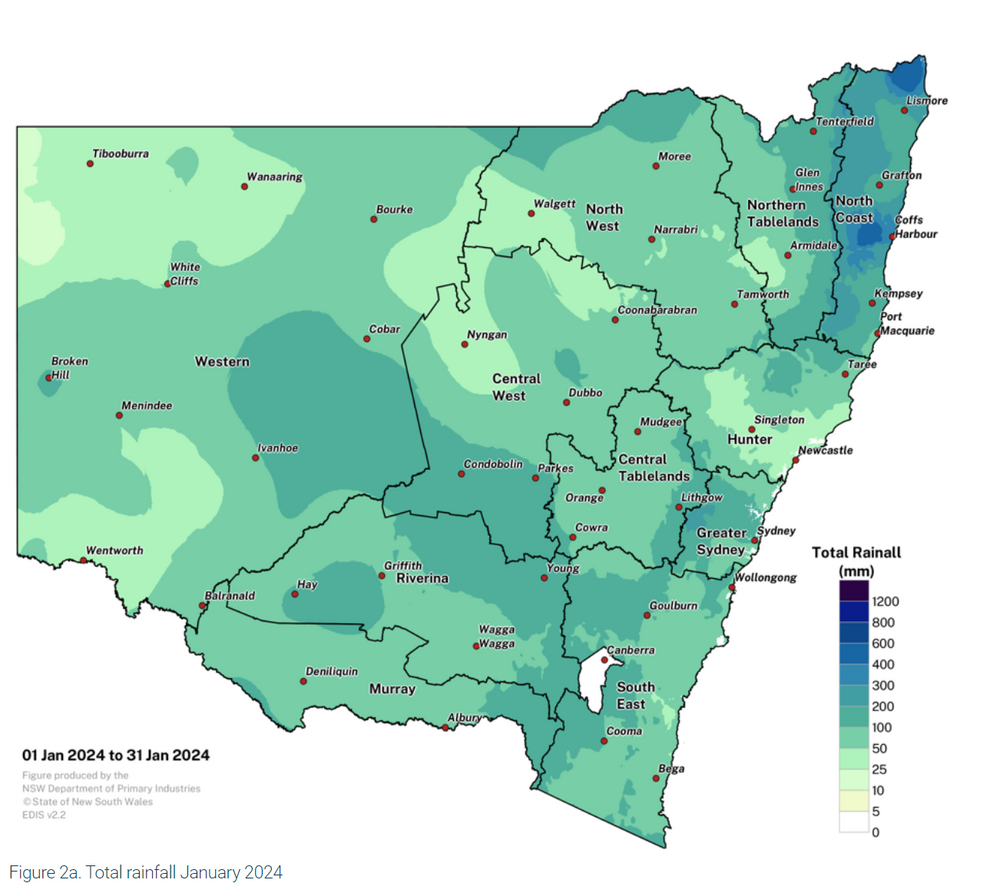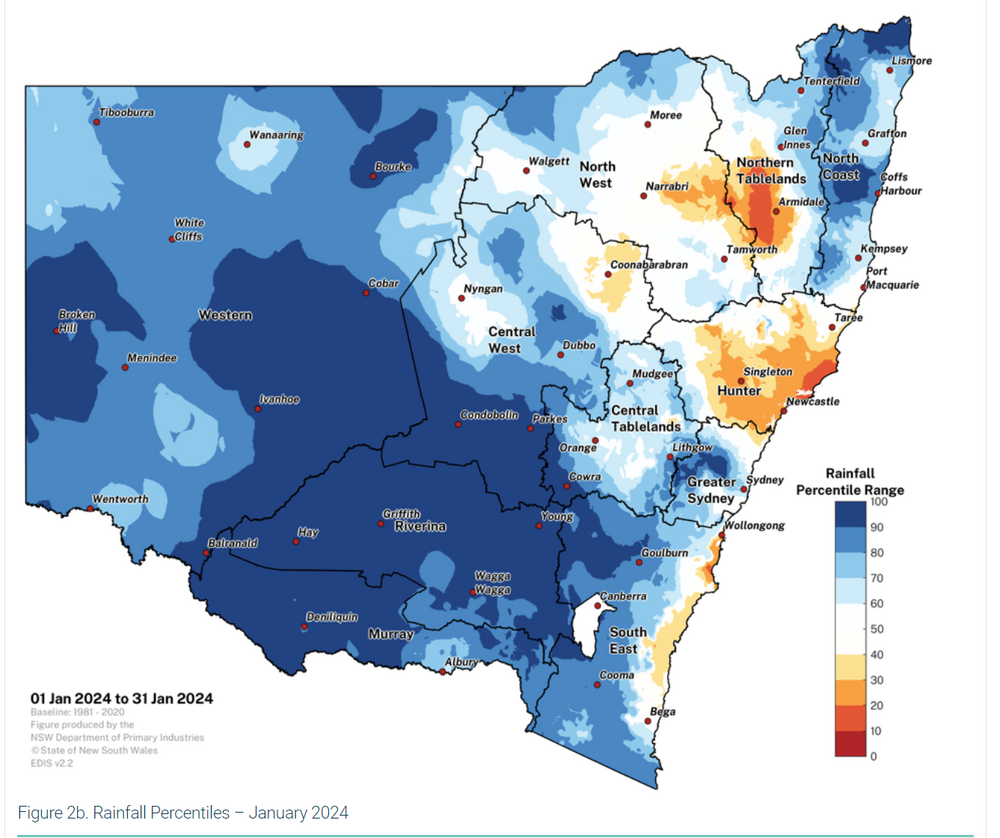Climate change whiplash or wacky weather?
Kristin Murdock
12 February 2024, 6:40 AM
 Rain or dry weather? We tell you what to expect. (Image ABC News)
Rain or dry weather? We tell you what to expect. (Image ABC News)Heatwaves and summer rains have made the past few months very interesting on the weather front (pardon the pun!). Even the Bureau of Meteorology (BOM) has named January as a month of 'instability' for weather events.
BOM has just released a seasonal update showing that 53 per cent of NSW is in one of three drought categories. These are 'drought affected (weakening), 'drought affected (intensifying) and just plain 'drought'. Widespread rainfall throughout January has continued to ease drought conditions for some areas of NSW, yet the majority of the Western Plains comes under the drought affected (intensifying) category.
New South Wales overall had 428.89 mm rainfall in 2023, as an area average across the state, which is 22.9% below average. The mean temperature was 1.30 °C warmer than the 1961–1990 average, making it the sixth-warmest since records began in 1910.
Of interest to Western Plains residents is that the water level decreased in the Menindee Lakes throughout the year and ended at 59.2% by the end of 2023, significantly lower than the same time last year (119.8%). Surface water storages declined in 2023, including those in the Murray–Darling Basin. However, Australia's total surface water storage volume remained high at the end of 2023 (74.1% of its accessible capacity).
That's a lot of figures, but one thing is for certain, weather patterns have been unpredictable. The Climate Council is calling this "Climate Change Whiplash", claiming that climate change, driven by the burning of coal, oil, and gas, is supercharging Australia’s weather systems, making them more unpredictable and dangerous than ever before.
Professor Lesley Hughes, Climate Councillor had the following to say.
“Wild swings from fires to floods are threatening the people we love and the places we call home. Climate change, driven by the burning of coal, oil, and gas, has worsened Australia’s weather from coast to coast, with almost every state breaking extreme weather records this summer," he said. "This report makes it clear that we can no longer rely on the past to predict the future when it comes to our weather. Climate change is causing erratic swings from sweltering heat to devastating downpours, and it is increasingly hard to predict what each season will bring."
Dealing strictly in factual data, BOM has just released its Annual Climate Statement for 2023 which includes a full analysis and description of last year's temperature, rainfall, hydrology statistics, sea ice, oceans, greenhouse gases and significant weather events. The report confirms 2023 was warmer than average for Australia overall, while it was a year of contrast between the north and south for rainfall. Since temperature records began in 1910, 2023 was the equal eighth-warmest year on record and the warmest since 2020.
Proponents of Climate Change and general weather watchers will both be interested in the following national facts.
- Winter 2023 was Australia's warmest on record, with the national mean temperature 1.53C above the 1961–1990 average.
- September 2023 was Australia’s driest September on record with total rainfall around 70% below the 1961–1990 average, and the second driest month since national rainfall records began in 1900, behind April 1902.
- August to October 2023 was Australia's driest three month period since rainfall records began in 1900.
- Sea surface temperatures for the Australian region were the seventh-highest on record since 1900 at 0.54°C above the 1961–1990 average.
- Globally, sea surface temperatures were the highest on record – and each of the past 10 years have been among the 10 warmest on record.
- Throughout 2023 net Antarctic sea-ice extent was either at record low levels or well below the 1991–2020 average – based on continuous satellite imagery since 1979.
- Climate change continues to influence Australia's climate. Since national records began in 1910, Australia's climate has warmed around 1.5°C.

In their seasonal outlook, BOM say indications are there is 35% to 55% chance of above median rainfall for most of NSW for the February to April period. Parts of eastern NSW and the far west have a 20 – 40% chance of above median rainfall for this outlook period. Temperatures are expected to be well above median across NSW.
Hot and wet seems to be the outlook, and above average rainfall has already been recorded. January rainfall was above the 60th percentile of the historical record for large parts of NSW with some areas of the state having falls above the 90th percentile. The January rainfall percentile map ranks the total rainfall for January 2024 compared to long term records from 1981-2020.
Unpredictable weather systems mean the decision-making environment continues to be challenging for many NSW farmers, BOM say that available remote sensing information of pasture conditions highlights that there is considerable variability within and between regions. Farm water supply is also variable across many regions due to hot conditions and variable rainfall throughout January.
Climate Council warns that the weather of the past may no longer be a reliable guide for the future saying that "hot on the heels of El Niño come concerns that La Nina, a climate driver associated with floods and storms, may return as early as mid year."

BOM's take on the El Nino/ La Nina weather phenomenon is as follows.
"After three years consecutive years of La Niña and widespread rainfall, La Niña weakened and dissipated through summer 2022–23. The other major global-scale influences on Australia’s climate in 2023 were El Niño and a strong positive Indian Ocean Dipole which were established in early spring, and a positive phase of the Southern Annular Mode towards the end of the year."
So what does it all mean? No-one can predict the future, but it's fair to say, as far as weather goes, be prepared for anything!



